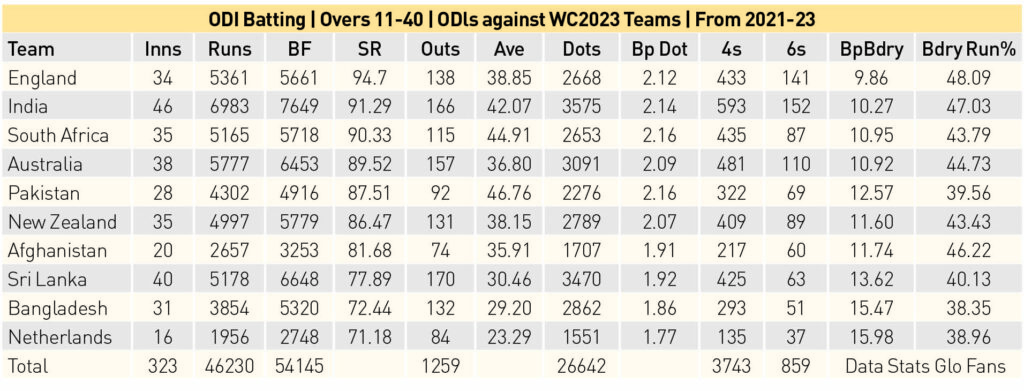New Delhi
In a surprising turn, South Africa has exceeded expectations by clinching the prestigious third-favourite position in cricket data analysis, edging out Australia. This determination stems from a thorough and painstaking examination of 323 matches played by the ten participating World Cup teams between 2021 and 2023, with a primary focus on the fiercely competitive arena of One Day International (ODI) encounters.
This data underscores the undeniable significance of ODI matches, particularly during the crucial phases spanning over 11 to 40, where the outcomes often wield a profound influence on overall game results. Importantly, this comprehensive dataset solely encompasses matches contested among the ten participating nations, excluding any teams outside this select group.

With an extensive dataset comprising 323 innings, the spotlight now turns to South Africa’s remarkable resurgence on the cricketing stage. Their rise to this esteemed third-favourite position beckons a deeper exploration of their performance during this specific time frame, unearthing invaluable insights capable of reshaping perspectives and expectations within the cricketing community.
England, the defending champions, claimed the top spot with an impressive strike rate of 94.70. What sets them apart is their remarkable ability to minimize dot balls, with an average of only 9.86 balls per boundary and a boundary run rate of approximately 50%, that is, only half of their runs total were scored by running double, which also helped England to score over 300 runs. The influence of their coach, Brendon McCullum, who emphasizes a dynamic style of play, is evident in their batters, nine of whom have achieved ODI centuries.
Surprisingly, it’s India, not Australia, that secures the second position, having played 46 ODI matches during this period. India’s strength lies in their solid middle-order performance, with the highest number of runs aggregated and balls faced. They maintain the second-best strike rate at 91.29 and a low 2.14 balls per dot. In contrast to England, India heavily relies on boundaries, hitting 152 sixes in 46 matches, surpassing England’s 141 in 34 matches. Their strategy revolves around aiming for sixes, aerial shots, and quick two-run conversions during decisive overs.
Australia, having played 38 matches, secures the fourth spot, amassing 5,777 runs at a strike rate of 89.52. They rank second in boundary-hitting, with India leading the pack with 593 boundaries while Australia is close behind with 481.
South Africa, with 35 matches played, boasts a healthy strike rate of 90.33, resembling Australia’s batting prowess. In these matches, South Africa scored 5,165 runs while facing 5,718 balls.
In a surprising turn of events, last-time finalist New Zealand finds itself in the sixth position among the ten participating teams. A notable commonality between New Zealand and England is their preference for a lower number of balls per dot and a different average. New Zealand places a heavy emphasis on running between the wickets, setting them apart from England.
The Netherlands, the newcomers who stunned the cricket world by eliminating West Indies from the World Cup qualifiers, played only 16 matches. The Flying Dutchmen is the only team that has scored less than 2,000 runs with limited matches and even less international exposure. Eight of the team’s top players were playing in the county while the Dutch team gathered to play at the World Cup qualifiers in Zimbabwe. The Dutch played with a strike rate of 71.18. While lacking experience, their youthful squad showcases electrifying running between the wickets and agility in the field, resulting in several closely contested matches.
In the upcoming 2023 World Cup, one can expect India, England, South Africa, and Australia to field the strongest batting lineups. These teams have consistently demonstrated their ability to score effectively during the critical overs spanning 11 to 40.
India stands as the favourite to win the World Cup, boasting a formidable batting lineup that combines experience with youthful talent, capable of posting substantial totals.
England also ranks among the top contenders, thanks to their aggressive and high-scoring batting order, known for swiftly accumulating runs.
South Africa and Australia, both possessing strong batting units, aim to challenge India and England for the coveted World Cup title.
The 2023 World Cup promises an exciting spectacle, where batting prowess will play a pivotal role in determining the tournament’s victor, and the team with the most formidable batting lineup is likely to emerge victorious.
Sunil Yash Kalra is a Women’s Cricket Historian and founder of Indian Sports Fans.

